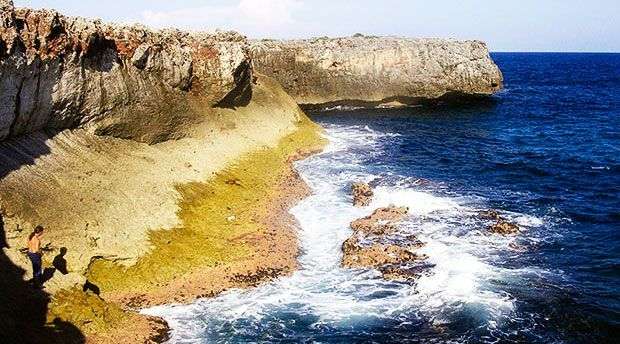In Guanahacabibes, the hours are marked more by the sun than by any clock, and every rock, nook, strip of beach and cave has a history.
The peninsula (456.76 square miles, located in the municipality of Sandino), is divided into two capes: Corrientes in the east and San Antonio in the west. To get there from the city of Pinar del Río, you take the Panamericana highway–an extension of Cuba’s Carretera Central, or central highway–which was named that way because it was part of an intercontinental project in the 1930s that was going to make Cuba into a ferry port.
The peninsula has a population of about 38,896 (23 per square kilometer, or 0.39 miles), with 58 percent living in urbanized
areas. Local residents work mostly in environmental management, tourism, and conservation and preservation of the forests that were declared a World Biosphere Reserve by UNESCO in 1987. The core of this reserve, the Guanahacabibes national park, has two natural reserves: El Veral and Cabo Corrientes.
Faro Beach (on the Cape of San Antonio) is Cuba’s westernmost tip. On a raised terrace, the internationally-known Faro Roncali (lighthouse) has stood since the mid-19th century. It is about 102 feet high, and was completed during the mandate of the island’s colonial governor, Federico de Roncali.
The spelling of Guanahacabibes, a name pronounced by Cuba’s indigenous people as Guanajacabibes, has varied over the years: Guanacabibes, Guanacahibes, Guanahatabibes, Guanacahive and Guanacavive. It is a compound word from the Arawak language, and can be interpreted as place of the iguanas or site of the iguanas: Guana (iguana), ha (yes), cabibes (site or place).
The area’s primitive inhabitants—from the Mesolithic or pre-agricultural and pottery culture—who benefited from the lush forests, caves, and enviable land and sea food sources—left their mark on more than 150 archeological sites in these surroundings. Spanish chroniclers, such as Padre de Las Casas, wrote about these people referring to them as Guanahatabeyes.
The natural attractions of Guanahacabibes explain why ecotourism is preferred here: small, solitary beaches shaped like coves, where giant sea turtles come ashore on summer nights; the so-called casimbas or cenotes (limestone sinkholes with natural pools), great for cave diving, such as the Valle de San Juan, Poza Redonda and Juan Claro; and docks for international vessels, with comfortable tourist facilities: María la Gorda and Playa las Tumbas, home to Cuba’s most beautiful sea bottoms, with their protected coral reefs and caverns full of fish, gorgonians, shellfish, and black coral.
Stories and legends, both interesting and sinister, are associated with the local caves—Las Perlas, El Negro, La Barca, La Sorda and La Mina— where examples of indigenous cave art and archeological specimens can be found: pirates, shipwrecks and buried treasure, such as in the Catedral de Mérida, or the treasure of the cave Perjuicio (named after a buccaneer who supposedly buried it there). There are also stories about poor villages and settlements—such as Gururú, Carabelita, Bolondrón, and Santa Cruz—where Spaniards and free blacks survived by making charcoal, tree-cutting, and selling honey, and where the arrival of a woman would lead to a dispute to the death for her hand.
The biodiversity of Guanahacabibes is among the richest in flora and fauna, both land and marine, in the Caribbean islands, including its endemic species, many exclusive to the area: deer, which bound away when humans pass; the iguana and jutía (tree rat), which scuttle over the coastal cliffs at midday; and the crocodile, king of the swamps and lagoons of Cayo Los Pájaros, a cay that is home to the largest natural reserve of aquatic birds in the area. Clouds of migrating birds fill the forests in wintertime: the miniature hummingbird known as the zunzuncito, the smallest bird in the world; the colorful tocororo; the melodious nightingale….
In this fascinating place, where nature and humanity walk hand in hand, many secrets still remain; Guanahacabibes changes every day. Plants and animals are born, birds migrate, the karstic landscape takes form, and the sediments continue their movement, guided by the laws of life.
By: Pedro Luis Hernández Pérez






















